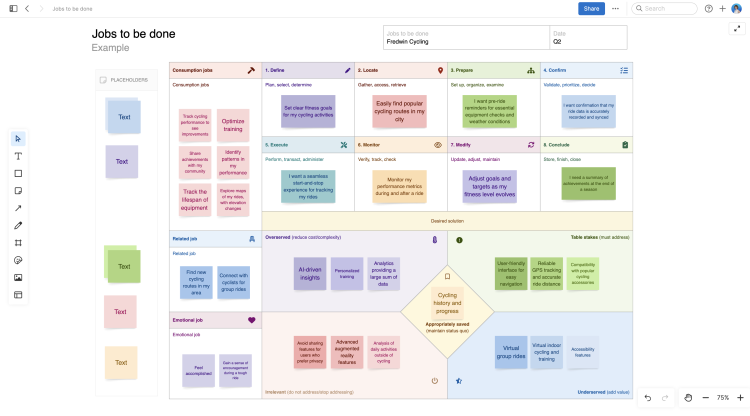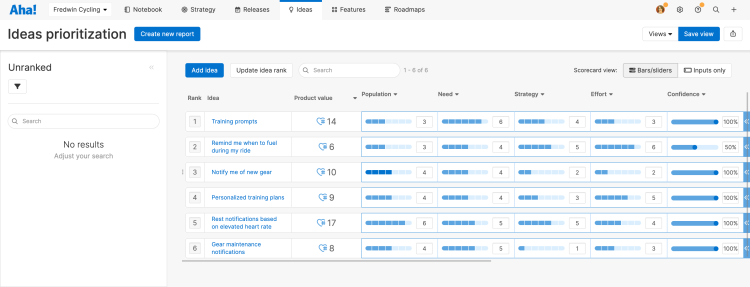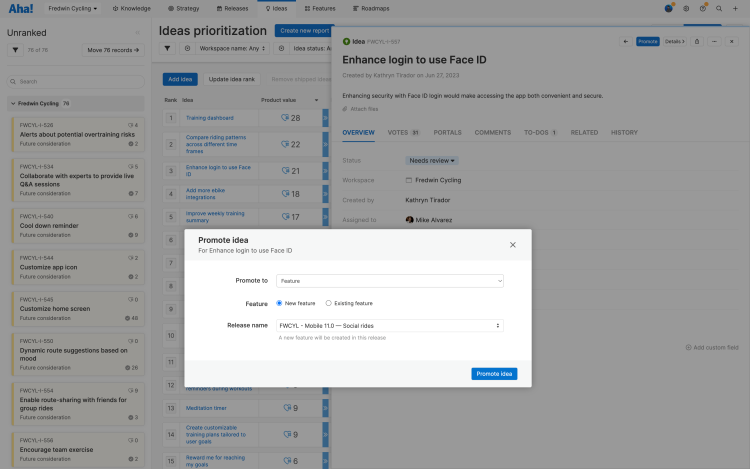This article is one of a six-part series on stakeholder alignment throughout the product development lifecycle.
Aha! Roadmaps | Best practices for stakeholder alignment: Prioritize the best ideas
This best practices article is part three of a series focused on driving stakeholder alignment. In the previous article, we discussed the importance of reviewing customer feedback to make sure your product strategy serves your customers' needs — as well as your business's. We also recommended that you gather early input from internal stakeholders to bring fresh thinking into the planning process.
At this point, there is likely no shortage of ideas. Which means that you will need to make tough prioritization decisions. Getting your stakeholders to agree on which features matter the most can be tricky. Each group — like marketing, sales, and support — will have different points of view and different priorities. This is why it is so important to put strategy first. When everyone understands what you need to accomplish and why, you can have an objective conversation about which ideas will have the biggest impact.
Aha! Roadmaps provides a wide variety of tools to help guide those conversations. Whether you are using different frameworks to think through approaches, scoring the potential value of ideas, or ranking them in priority order, the key is being transparent about your approach and getting stakeholder buy-in as you go.
Click any of the following links to skip ahead:
Step 1: Explore the possibilities
The research that you conducted to shape your strategic initiatives provides a solid foundation for everything you want to accomplish. Now, it is time to explore the best way to address your customers' needs. Whiteboards are perfect for coming up with innovative solutions and refining them with the team.
Choose from a variety of pre-built templates — such as the Jobs to be done, Mind map, or Problem framing templates — to determine what customers need.
Pull related ideas in Aha! Roadmaps onto your whiteboard (individually or in bulk) to see which ones best help your customers achieve their goals. Use sticky notes to capture new ideas that emerge.
Weigh up the pros and cons of different approaches or complete a proof of concept to validate your assumptions and assess the feasibility of new ideas.
Share your whiteboard with different stakeholders, scheduling sessions as needed to collectively review and refine the details. Encourage team members to add comments, share insights, and highlight areas that require deeper discussion. This collaborative approach streamlines decision-making and leads to better solutions.

Step 3: Assess product value
Now that you have identified the top ideas for each initiative, the next step is to evaluate their relative importance and agree on their priority. Use the prioritization view in Aha! Roadmaps to create a list of all the ideas you are considering. Then, add a product value score to vet each idea based on a standard set of metrics:
Population: How many customers will it impact?
Need: How important is it for those who require it?
Strategy: How closely connected is it to the company/product strategy?
Effort: How much work will it take to build?
Confidence: What is the level of confidence in each score?
This helps you establish a standardized method for estimating the value of work. Besides this, be sure to use data wherever possible to inform your scores. For example, you could use the number of votes an idea received in your portal to inform the population score. Or you might use the potential revenue associated with each idea (easily captured via our Salesforce integration) to assess the overall need.
Share your prioritization view with the team and adjust the scores together based on new insights. Then, place the ideas in priority order as you reach consensus about which ones will have the biggest impact.

Step 4: Prioritize the most valuable work
You now have a clear set of priorities to inform your roadmap. It is time to take the next step and promote the best ideas to features. (You can do this by opening each idea record directly from the prioritization view.) Remember to link each feature to the right initiative so you can show how your product strategy ties together.

Of course, your priorities might shift as you go deeper into the planning process. Keep refining product value scores as you do more research, define each feature, and add new ideas to the mix. It is important to remain open to suggestions and feedback throughout the planning process to do the right things for your customers and the team.
Now that you have reviewed and prioritized customer feedback, and aligned it against your strategic themes, you have all the elements you need to create your product roadmap.
